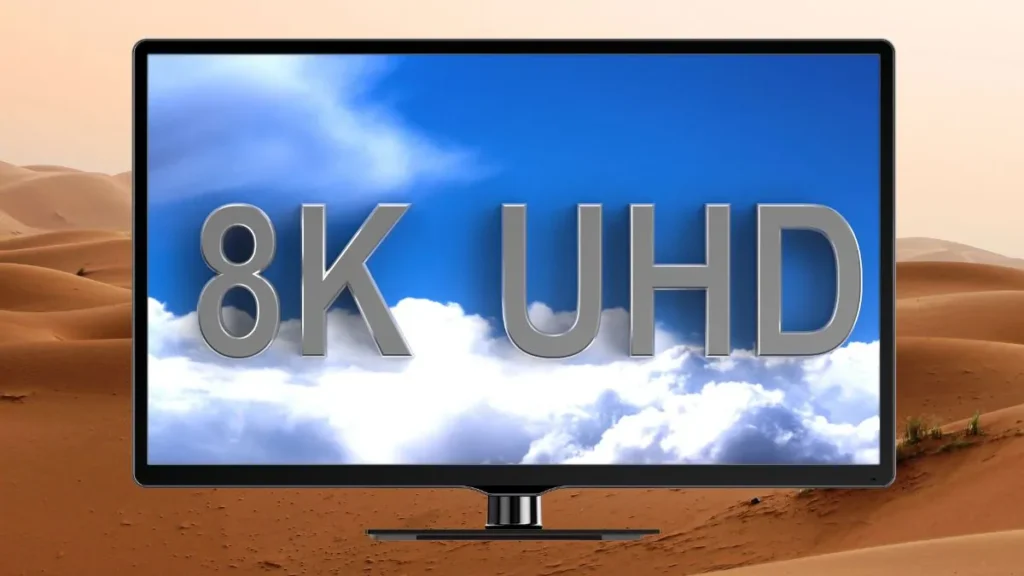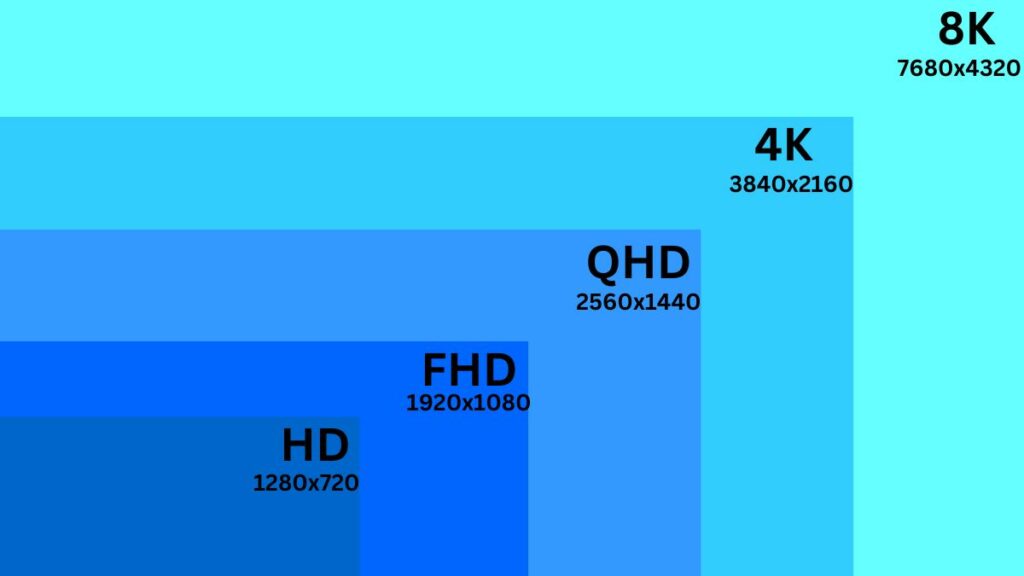Ultra High Definition (UHD), also known as 4K or 8K, is a display resolution four times the Full HD resolution, resulting in a clearer and more detailed image. Its minimum resolution is 3840×2160 pixels, totaling over 8 million pixels.
It provides extremely fast performance of movies, photos, and games. With Ultra HD, images and videos come to life on the screen, revealing better detail, more vibrant colors, and an overall quality that sets a new standard for visual excellence.
UHD Definition
The full form of UHD is Ultra High Definition. The resolution of Ultra HD displays is four times higher than Full HD. Its minimum resolution is 3840×2160 pixels, more than 8 million pixels.
UHD is called 4K UHDTV or simply 4K. The terms UHD and 4K are often used interchangeably, but there are slight differences between the two. Ultra HD is a broad term that refers to both 4K and 8K displays. At the same time, the standard resolution for 4K is 3840×2160 pixels.
Concept of UHD

UHD, which stands for Ultra High Definition, displays ultra-detailed images and video on a TV or computer screen. It makes everything clearer and more vivid. Ultra HD is also known as 4K or 8K. 4K Ultra HD displays have four times more pixels than Full HD. It is very popular, and UHD is 4K. 8K is also relatively fast but less popular because it requires a lot of unique things to work properly.
The increased resolution leads to greater detail on the display, particularly noticeable in close-ups and wide-angle shots. UHD displays offer a broader color gamut than Full HD, HD, and lower resolutions. This wider color range enhances the display’s ability to render a more extensive spectrum of colors.
In addition to improving resolution and color gamut, Ultra HD has higher frame rates, allowing it to display images smoother, reduce motion blur, and provide a better viewing experience.
Practical Uses of UHD

Home Entertainment
UHD is most used for home entertainment because its video looks clean and clear. With 4K and 8K TVs, watching movies, sports, and TV shows is a joy with sharp, detailed images.
CCTV Surveillance
UHD is used in CCTV cameras and monitors surveillance systems to provide better image quality, helping to identify people and objects in real time.
UHD In Gaming
UHD displays are a game-changer for gaming as modern gaming consoles and high-end gaming look great. Gamers enjoy enhanced graphics, smoother gameplay, and a more immersive gaming experience on this UHD display.
UHD In Content Creation
Better Image Quality: UHD is used in content creation because Ultra HD content is much sharper and more detailed than traditional HD content. UHD content makes creating a more realistic viewing experience for viewers. This is especially important for 3D content and content intended to be immersive, such as virtual reality (VR) and augmented reality (AR) content.
It offers a wide color gamut. This causes it to display a wider range of colors. Its higher frame rate displays UHD content more smoothly, reducing motion blur and improving the viewing experience.
Education
UHD is used to create interactive learning experiences and deliver high-quality educational content to students. UHD displays virtual reality simulations or provides students with close-up views of microscopic objects. Teachers and students get crisp and clear viewing of PDFs, e-books, presentations, and other reading materials on the Ultra HD display.
Virtual Meeting
UHD is used in virtual meetings for better image quality, producing a sharper and more detailed image than traditional HD video conferencing. The Ultra HD camera and display deliver sharp and clear video quality. Displays with UHD resolution make it easier to understand facial expressions during virtual meetings.
It displays high-quality text and graphics when sharing documents, presentations, or screens during virtual meetings. Apart from this, if the webcam supports UHD, it has a wider field of view than traditional HD webcams.
Mobile Phone
UHD displays are used in most high-end smartphones; these displays provide sharp and vibrant visuals, providing a better viewing experience of videos, photos, games, and applications.
This offers better image quality, making photos and videos clear and crisp. If the mobile camera supports UHD, it records high-resolution videos, making the recorded videos look great and capturing high-resolution images with fine details.
It is also used to stream 4K and 8K videos from platforms like YouTube, Netflix, and Amazon Prime Video to enjoy UHD content.
Why UHD is Important?

Wider Color Gamut
UHD displays support a wider color gamut than Full HD displays, allowing UHD displays to display a wider range of colors, making content more vibrant and realistic.
Higher Frame Rates
UHD displays have higher frame rates, making it easier to display Ultra HD content more smoothly, improving the overall viewing experience by reducing motion blur.
Better Communication
UHD video conferencing and virtual meetings allow participants to see facial expressions and details, making remote communication more effective and personal.
Enhanced Visual Quality
Ultra High Definition delivers four times the standard and full high definition (HD) resolution, resulting in sharper, clearer, and more detailed visuals, providing a more immersive and enjoyable viewing experience.
Immersive Entertainment
UHD provides a more immersive experience when watching movies, TV shows, and playing video games, making on-screen content appear more lifelike and engaging.
UHD (4K) vs. Other Resolutions
| Display Resolution | Full Form | Aspect Ratio | Pixel Dimensions | Commonly Used In |
|---|---|---|---|---|
| 4K UHD (Ultra HD) | 4K Ultra High Definition | 16:9 | 3840 x 2160 pixels | High-end TVs, monitors, gaming systems |
| HD (720p) | High Definition | 16:9 | 1280 x 720 pixels | Entry-level smartphones, budget TVs |
| HD+ | High Definition Plus | 18:9 or 19.5:9 | 1600 x 720 pixels | Entry to mid-range smartphones, tablets |
| FHD (1080P) | Full High Definition | 16:9 | 1920 x 1080 pixels | HDTVs, monitors, smartphones, tablets |
| QHD (2K) | Quad High Definition | 16:9 | 2560 x 1440 pixels | High-end smartphones, tablets, monitors |
| 8K UHD (Ultra HD) | 8K Ultra High Definition | 16:9 | 7680 x 4320 pixels | Cutting-edge TVs, professional displays |
| WQXGA | Wide Quad Extended Graphics Array | Varies | 2560 x 1600 pixels | High-end monitors, laptops |

The Advantages of UHD Screen
Higher resolution
UHD screens have significantly higher resolutions than standard high-definition (HD) screens. 4K screens have a resolution of 3840 x 2160 pixels, while 8K UHD screens have a resolution of 7680 x 4320 pixels.
Increased Clarity
UHD screens have higher pixel density. Its pixels are smaller and less visible to the naked eye. This produces a sharper image, reducing the ‘screen-door effect’ often associated with low-resolution displays.
Vivid Colors
Ultra High Definition screens often feature advanced colors like high dynamic range (HDR), providing a wider color gamut and better contrast. This results in brighter and more vibrant colors, enhancing the viewing experience.
Larger Screen Sizes
Mostly, UHD technology is used in larger screen sizes. With UHD screens, enjoy larger displays without loss of image quality. This is beneficial for home theatre and commercial displays.
Great Gaming Experience
UHD screens are great for gamers as they provide a more immersive and detailed gaming experience. Nowadays, gaming consoles and PCs come with UHD resolution.
Content Creation
UHD screens are essential for content creation, editing, and producing high-quality videos and images. This allows you to see the content in detail and make precise adjustments.
Improved text legibility
UHD screens make text and small details in documents, spreadsheets, and websites more legible, reducing eye strain and improving productivity.
Which display resolution should you choose?
HD (720p)
This is good for smaller screens, like smartphones, small-screen monitors, and laptops. It is suitable for basic video streaming, web browsing, and general computing tasks. It also makes less demand on device resources, which extends battery life on portable devices.
It needs more detail and high-resolution clarity, making it unsuitable for larger screens and tasks requiring more detail.
Full HD (1080p)
Nowadays, FHD resolution is standard in basic devices such as laptops, desktop monitors, gaming, and TVs. It offers a good balance between details and performance. It’s fine for everyday computing, streaming, gaming, and media consumption.
It does not provide the highest level of detail available, especially when viewed on large screens or in professional applications.
Quad HD (1440p)
The QHD is used in large desktop monitors, laptops, and high-performance smartphones. It offers more screen real estate and detail than Full HD. Great for productivity, content creation, and gaming. Also, it provides a balance between performance and quality.
Higher demands for processing power and resources can impact the battery life of portable devices.
Ultra HD/4K (2160p)
Great for large desktop monitors, high-end laptops, gaming, video editing, and 4K TVs, it’s excellent for content creators, gamers, and media enthusiasts, enhancing immersion and clarity on larger screens.
Handling 4K content effectively requires more powerful hardware. 4K content is less widely available than Full HD content and consumes more data and storage space.
Final Word
UHD, or Ultra High Definition, refers to displays with a minimum resolution of 3840 x 2160 pixels, four times that of Full HD. This higher resolution leads to sharper image quality, increased realism, a broader color gamut, and higher frame rates. Ultra High Definition technology is continually evolving.
UHD displays are used in various industries, including entertainment, broadcasting, education, and medicine. As Ultra High Definition technology continues to evolve and become more affordable, we may see even more innovative and practical uses for Ultra High Definition in the future.
FAQs
Its standard resolution is 3840×2160 pixels, while its highest resolution is 7680×4320 pixels.
UHD resolution is four times higher than Full HD, resulting in a clearer and more detailed image.
There is not much difference between UHD and 4K. UHD is sometimes also called 4K, and there is a slight difference in resolution. The standard resolution of UHD is 3840 x 2160 pixels, while 4K is 4096 x 2160 pixels.




